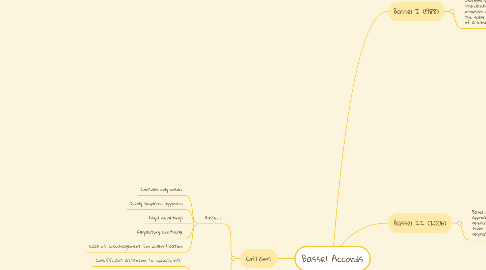
1. Bassel I (1988)
1.1. Uniform system of capital adequacy standards for banks. Stipulates a minimum of 8% of capital to support the value of the risk weighted assets of a bank.
1.1.1. Capital Ratio (Minimum 8%) = Capital (Tier 1 + Tier 2)/Risk Weighted Assets
1.1.1.1. Tier 1 Capital: paid-up share capital and disclosed reserves (less goodwill)
1.1.1.1.1. Tier 1 capital should be at least 50% of the total capital.
1.1.1.2. Tier 2 Capital: supplementary capital, comprises undisclosed reserves, loan loss allowances/reserves, asset revaluation reserves, hybrid capital instruments (such as mandatory convertible debt, etc.) and subordinated debt.
1.1.1.3. Risk Weighted Assets:Assets in the balance sheet of a bank are assigned different risks under Basel I, based on their inherent risk
1.1.1.3.1. 100% = Direct Credit Substitutes – Guarantee of Indebtedness
1.1.1.3.2. 50% = Transaction Related Contingencies (Bid Bond, etc.)
1.1.1.3.3. 20% = Letters of Credit, Collateralized by Underlying Shipments
1.1.1.3.4. 0% Certain Commitments that are Cancellable Unconditionally
2. Bassel II (2006)
2.1. Basel II presented a more sophisticated approach to the calculation of minimum regulatory capital and introduced a three-pillar infrastructure that seeks to align regulatory capital with economic capital.
2.1.1. Pillar 1 (Minimum capital requirements): similar risk capital ratios as per Basel I, albeit with the incorporation of operational risk
2.1.1.1. Capital Ratio (Minimum 8%) = Tier 1 + Tier 2 Capital/RWA (Credit, Market & Operational)
2.1.1.1.1. Credit Risk
2.1.1.1.2. Market Risk
2.1.1.1.3. Operational
2.1.2. Pilar 2 (Supervisory Review): Meant to identify risk factors not captured in Pillar 1, giving regulators the ability to adjust the capital requirements calculated under Pillar 1.
2.1.3. Pilar 3 (Market Discipline): promote market discipline through enhanced disclosure by banks by setting out detailed disclosure requirements and recommendations in a number of areas.
3. Bassel III (2008)
3.1. Prescribes more liquidity measures and buffers along with tighter control on leverage. The Basel III structure retains the Pillar I, Pillar 2 and Pillar 3 approaches; however Pillar 1 has several new features aimed at improving and strengthening the capital position of banks and FIs
3.1.1. Credit Risk
3.1.1.1. Major Changes
3.1.1.1.1. Use of stress-tested PD
3.1.1.1.2. Strengthens the requirements for the capital against credit risk
3.1.1.1.3. Identify instances of wrong way risk within counterparties
3.1.1.1.4. Tighter controls on OTC derivatives
3.1.1.1.5. Introduction of CVA (Credit Value Adjustment)
3.1.1.2. Key Features
3.1.1.2.1. Raising the quality, consistency and transparency of the capital base
3.1.1.2.2. A leverage ratio to help prevent the build-up of excess leverage that can lead to the de-leveraging ‘credit crunch’ situation
3.1.1.2.3. A series of measures are proposed to deal with pro-cyclical factors.
3.1.1.2.4. Introduces a global minimum liquidity standard for internationally active banks which includes the following:
3.1.2. Market Risk
3.1.3. Operational Risk
4. Critisms
4.1. Bassel 1
4.1.1. Consider only credit
4.1.2. Overly simplistic approach
4.1.3. Rigid weightings
4.1.4. Regulatory arbitrage
4.1.5. Lack of encouragement for diversification
4.2. Bassel 2
4.2.1. Insufficient attention to liquidity risk
4.2.2. Increased pro-cyclicality and higher leverage
4.2.3. Questionable correlation assumptions
4.2.4. Over-reliance on external ratings
4.2.5. Usage of questionable risk management systems
